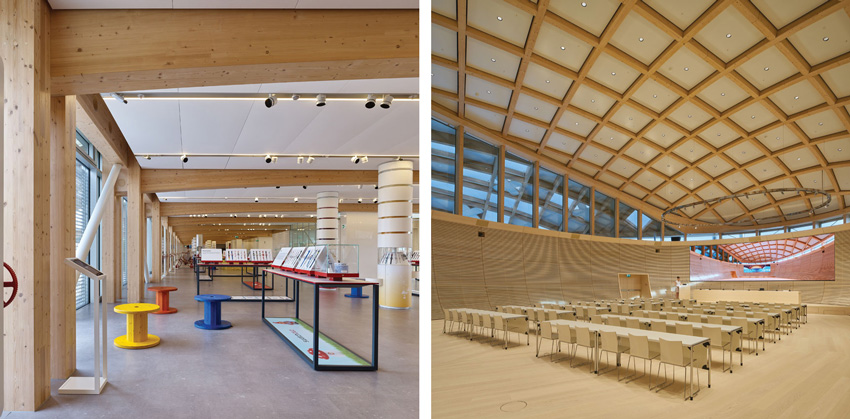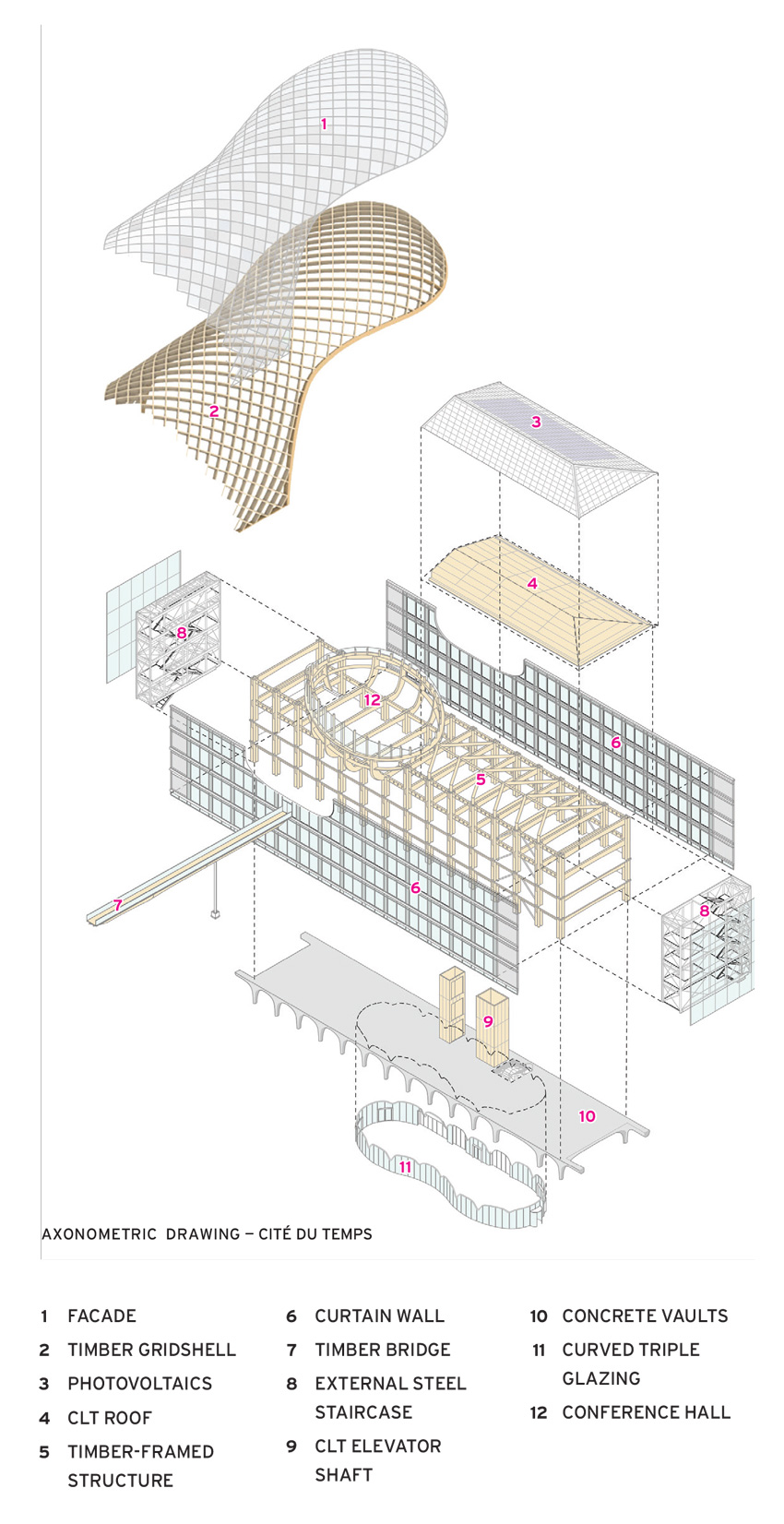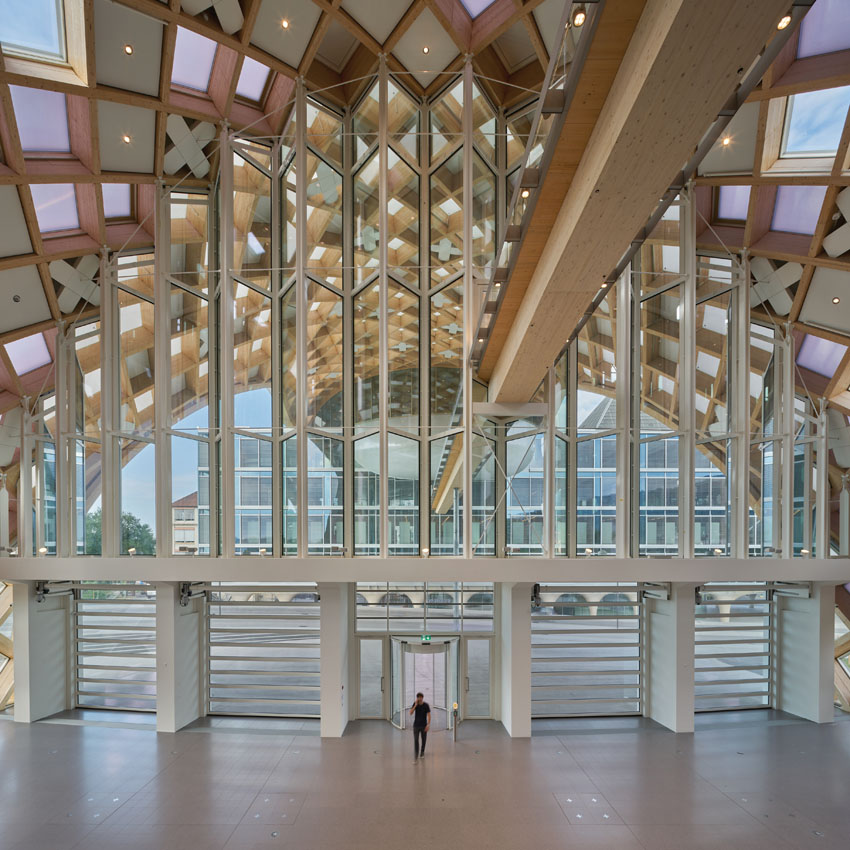This CE Center article is no longer eligible for receiving credits.
View course on architecturalrecord.com »
Japanese architect Shigeru Ban likes to test the limits of materials. The Pritzker Prize–winner is perhaps best known for his work with cardboard tubes, using them to quickly and inventively shelter victims of disasters. But wood is another favorite. With timber serving as the primary structural material, he has created wildly sculptural buildings, such as the Centre Pomipidou’s branch in Metz, France (architectural record, July 2010), with a swoopy, tentlike wood gridshell roof said to be inspired by woven bamboo hats. He has also designed more sedate wood buildings, including a headquarters for the Swiss media company Tamedia in Zurich (architectural record, July 2014)—a glass curtain wall–enclosed box that has a meticulously detailed timber post-and-beam framed structure exposed on the interior.

PHOTOGRAPHY: © NICOLAS GROSMOND
SWATCH HEADQUARTERS The office building’s serpentine form slinks along the River Schüss and connects to the Omega campus, literally embracing the complex’s museum.
One can find a little of both the Pompidou and Tamedia at Biel/Bienne, a watchmaking center that sits at the foot of the Jura Mountains on the border of the German- and French-speaking parts of Switzerland (hence its dual name). Here, after winning a 2011 competition, Ban has created a trio of buildings for the conglomerate Swatch Group—all with timber structures—set amid existing buildings on the campus of Omega, one of the many Swatch subsidiaries. Two of the buildings are rectilinear glazed volumes: a five-story Omega production facility and a 174,000-square-foot museum, devoted to both watch brands, that is topped with a 400-seat elliptical conference hall, which protrudes, bowl-like, from the top floor of the otherwise linear volume. But the most astonishing element of the assemblage is the new Swatch headquarters. This comprises three levels of open offices within a reptilian timber gridshell. The continuous, more than 100,000-square-foot surface, snakes—almost oozes—along the River Schüss and extends to shelter the entrance plaza and span a roadway, ultimately transforming into the roof of the adjacent conference hall. Ban explains the outlandish form of the headquarters as the product of its L-shaped site, but also as an expression of the colorful and playful Swatch brand.
The architect is often quoted saying that wood is the only truly renewable construction material. These three structures are made almost entirely of Swiss spruce, using 6,000 cubic yards of timber—an amount that is grown in the country’s forests every 10 hours, according to the project team’s calculations. But there are other reasons that make wood so attractive, says Ban. Especially when fabrication is done off-site, building with timber is quiet, fast, and precise. It can make finish materials unnecessary—and it has a pleasant smell, he adds.

PHOTOGRAPHY: © DIDIER BOY DE LA TOUR (TOP AND BOTTOM LEFT); SHIGERU BAN ARCHITECTS (BOTTOM RIGHT)
OMEGA FACTORY Inside the curtain wall–enclosed rectilinear volume (top) are timber-framed work spaces for assembling watches (bottom left). The columns and beams are spruce with beech dowels (bottom right).
The timber components at Biel/Bienne are put together almost entirely without metal connectors, so it can be tempting to liken them to Japanese carpentry. But the buildings are much more the outcome of advanced technology than they are the product of traditional craft. The parts were not fashioned from large, old-growth trees but were fabricated from engineered-wood elements, including cross laminated timber (CLT) slabs and glulam columns and beams—elements made by bonding small wood units together under pressure with high-performance adhesives. These pieces, many of them with compound curves, have been shaped and cut by CNC machines and other computer-controlled equipment. And the structures, especially the roof of the Swatch headquarters, are highly dependent on parametric design and computation. The resulting buildings are exact and have predictable behavior. Hermann Blumer, founder of structural engineering firm Création Holz and a frequent collaborator with Ban on his timber projects, points out that over the 800-foot-length of the curving gridshell, the construction tolerance is only ±¾ inch.


View course on architecturalrecord.com »
Japanese architect Shigeru Ban likes to test the limits of materials. The Pritzker Prize–winner is perhaps best known for his work with cardboard tubes, using them to quickly and inventively shelter victims of disasters. But wood is another favorite. With timber serving as the primary structural material, he has created wildly sculptural buildings, such as the Centre Pomipidou’s branch in Metz, France (architectural record, July 2010), with a swoopy, tentlike wood gridshell roof said to be inspired by woven bamboo hats. He has also designed more sedate wood buildings, including a headquarters for the Swiss media company Tamedia in Zurich (architectural record, July 2014)—a glass curtain wall–enclosed box that has a meticulously detailed timber post-and-beam framed structure exposed on the interior.

PHOTOGRAPHY: © NICOLAS GROSMOND
SWATCH HEADQUARTERS The office building’s serpentine form slinks along the River Schüss and connects to the Omega campus, literally embracing the complex’s museum.
One can find a little of both the Pompidou and Tamedia at Biel/Bienne, a watchmaking center that sits at the foot of the Jura Mountains on the border of the German- and French-speaking parts of Switzerland (hence its dual name). Here, after winning a 2011 competition, Ban has created a trio of buildings for the conglomerate Swatch Group—all with timber structures—set amid existing buildings on the campus of Omega, one of the many Swatch subsidiaries. Two of the buildings are rectilinear glazed volumes: a five-story Omega production facility and a 174,000-square-foot museum, devoted to both watch brands, that is topped with a 400-seat elliptical conference hall, which protrudes, bowl-like, from the top floor of the otherwise linear volume. But the most astonishing element of the assemblage is the new Swatch headquarters. This comprises three levels of open offices within a reptilian timber gridshell. The continuous, more than 100,000-square-foot surface, snakes—almost oozes—along the River Schüss and extends to shelter the entrance plaza and span a roadway, ultimately transforming into the roof of the adjacent conference hall. Ban explains the outlandish form of the headquarters as the product of its L-shaped site, but also as an expression of the colorful and playful Swatch brand.
The architect is often quoted saying that wood is the only truly renewable construction material. These three structures are made almost entirely of Swiss spruce, using 6,000 cubic yards of timber—an amount that is grown in the country’s forests every 10 hours, according to the project team’s calculations. But there are other reasons that make wood so attractive, says Ban. Especially when fabrication is done off-site, building with timber is quiet, fast, and precise. It can make finish materials unnecessary—and it has a pleasant smell, he adds.

PHOTOGRAPHY: © DIDIER BOY DE LA TOUR (TOP AND BOTTOM LEFT); SHIGERU BAN ARCHITECTS (BOTTOM RIGHT)
OMEGA FACTORY Inside the curtain wall–enclosed rectilinear volume (top) are timber-framed work spaces for assembling watches (bottom left). The columns and beams are spruce with beech dowels (bottom right).
The timber components at Biel/Bienne are put together almost entirely without metal connectors, so it can be tempting to liken them to Japanese carpentry. But the buildings are much more the outcome of advanced technology than they are the product of traditional craft. The parts were not fashioned from large, old-growth trees but were fabricated from engineered-wood elements, including cross laminated timber (CLT) slabs and glulam columns and beams—elements made by bonding small wood units together under pressure with high-performance adhesives. These pieces, many of them with compound curves, have been shaped and cut by CNC machines and other computer-controlled equipment. And the structures, especially the roof of the Swatch headquarters, are highly dependent on parametric design and computation. The resulting buildings are exact and have predictable behavior. Hermann Blumer, founder of structural engineering firm Création Holz and a frequent collaborator with Ban on his timber projects, points out that over the 800-foot-length of the curving gridshell, the construction tolerance is only ±¾ inch.


Of course, none of the structural systems for Ban’s Biel/Bienne buildings are entirely wood. All combine timber and reinforced concrete, but in different ways. The production facility, for instance, has a central concrete core that, in addition to housing stairs, elevators, and restrooms, also includes a highly secure and automated stockroom, where 26,000 storage boxes holding movements, cases, crystals, and other watch parts are retrieved by robots. Flanking the core on either side are the daylit spaces where the watchmakers assemble the timepieces. Ventilated to near clean-room standards, these wood-framed wings depend on paired columns rising the full height of the building and placed every 18 feet. They connect to beams that span from the perimeter to the core with cylindrical dowels made of beech—a species that is harder than spruce and therefore helps create a rigid connection. This framing supports floor slabs that are a composite of timber and concrete, to limit vibrations.
The museum, which has been dubbed the Cité du Temps by the client, has a timber structure for its curtain wall–enclosed upper floors with a system based on elegant groupings of four 11-inch-square columns placed every 16 feet along the perimeter. The oval conference hall, also framed in wood, with white ash ribs cladding its interior, is partially inserted within the upper reaches of the post-and-beam structure. This complete timber assemblage is lifted off the ground with sculptural and satin-smooth concrete piloti and vaults made with laminated timber formwork that has been shaved and shaped by CNC machines. This base’s permeability and its level of finish helps signal the open nature of the museum (the only public facility in the trio of new structures), points out Taro Okabe, director of Ban’s Paris office, where the project was based.


PHOTOGRAPHY: © DIDIER BOY DE LA TOUR
CITÉ DU TEMPS A bridge and an amorphous roof connect the museum (left) to the headquarters. Inside are dramatic spaces: a lobby (right); auditorium (bottom, left); and exhibition areas (bottom, right).
The Swatch headquarters also makes use of reinforced concrete. Here it forms the slabs of the three above-grade floors, which are completely enveloped by the self-supporting, undulant gridshell. As one might intuit, this serpent-like roof was the single most complex aspect of the three-building project. But the source of the challenge was not in figuring out how to make the free-form enclosure stand up. “In terms of statics, it is a vault or an arched bridge, which are forms that are familiar and well understood,” says Blumer. He explains that the problem was instead the integration of the timber components with the building infrastructure and with the 2,800 cladding elements, all roughly 7 feet square, but all uniquely shaped, of which there are three primary types: metal panels, glass, and cushions of ETFE (a strong and lightweight fluorine-based plastic). In addition to grappling with the variation, the design team also had to understand the unique thermal behavior of each material and how to accommodate cutouts for building infrastructure, including power, sprinklers, and the building automation network, but without compromising the structural integrity.

The initial cladding scheme was much more straightforward. In the competition submittal, the headquarters was almost entirely covered with the ETFE cushions. “We wanted to make the skin as light as possible,” says Ban. At that early stage, the depth of the timber and facade assembly was only about 35 inches. But, once the architects confronted such practicalities as the incorporation of radiant heating and cooling ceiling panels, the need for noise control (ETFE is a poor acoustic barrier), as well as compliance with Swiss labor regulations that required the inclusion of vision glass, the number of cladding types grew, as did the thickness of the envelope—to a hefty 55 inches. The increased dimension threatened Ban’s concept for the project, but also reduced the occupiable interior space, due to the site’s zoning restrictions.


To resolve the problem, the architects redesigned the enclosure, more tightly assimilating the mechanical services within the timber beams. And to avoid a coordination nightmare, they turned to a 3-D specialist, who helped define the interfaces among the structural components, the cladding elements, and the extensive infrastructure (see sidebar page 81). The new approach slimmed the depth of the assembly to just over 3 feet, and the results—especially inside—are quite successful. In particular, in the triple-story lobby and at the far end of the offices, where the floor slabs step down like mezzanines, the full 72-foot height of the lofty, vaulted interior is revealed. The roof structure appears as a honeycombed grid, and the distribution of its transparent, translucent, and opaque infill panels has an undeniable logic.
The exterior of the headquarters building, however, is less satisfying. Here the variety of cladding types create an unwelcome busyness, while other elements, including projecting balconies and necessities like snow fences (which prevent ice from dangerously sliding off the sloped facade) further add to the visual noise. In addition, after spanning the entry plaza and roadway, the roof awkwardly latches on to the smaller and much more restrained museum, nearly overpowering it.

PHOTOGRAPHY: © DIDIER BOY DE LA TOUR
SWATCH HEADQUARTERS The open office floors step down like mezzanines through the tubelike volume.
The true strength of the headquarters, and Ban’s entire Biel/Bienne ensemble, is revealed inside—it is here that the wood’s warmth shines. Within the buildings, where Ban’s skillful handling of timber connections, his exploitation of technology, and manipulation of structure are on full display, he has created lively and powerful spaces for Omega and Swatch.
Credits (Swatch Headquarters only)*
Architect: Shigeru Ban Architects Europe — Shigeru Ban, principal; Taro Okabe, project chief; Jonas Epper, deputy project chief; Matthieu Gabay, Takeshi Mitsuda, Takayuki Ishikawa, Maya Utsunomiya, Veronica Arianna, Emilie Bonzi, Michela Falcone, Alessandro Boldrini, Chika Tatsuta, Clotilde Varinot, assistant architects; Marc Ferrand, interior and product designer
Architect of Record: Itten+Brechbühl
Consultants: Création Holz, SJB Kempter Fitze, Schnetzer Puskas Ingenieure (structural); Transsolar Energietechnik (energy); CSD Ingenieure (building physics); Gruner Gruneko, ISP und Partner (HVAC, building automation); HKG Engineering (electrical); Hügli, BDS Security (security, fire); Leicht (facades); Design-to-Production (3-D specialist); Reflexion (lighting); Fontana Landschaftarchitektur (landscape)
Project Management: Hayek Engineering
Client: Swatch Limited
Size: 270,000 square feet
Cost: withheld
Completion Date: October 2019
SOURCES
Timber: Blumer-Lehmann
Glass Shutters: Bothe-Hild
Elevators: AS Aufüge, EMCH
Raised Foor: AGB, Cosentino
Resin Floor: Nocita
Interior Glass Walls: Glas Trösch
* See architecturalrecord.com for complete specs for the Omega and Swatch Headquarters buildings.
Supplemental Materials
Centre Pompidou Metz, by Rowan Moore
Quick Take: Shigeru Ban’s cardboard Cathedral, by Naomi Pollock, FAIA
Tamedia Headquarters Expansion by Shigeru Ban, by David Cohn
Aspen Art Museum, by David Hill
Fujisan World Heritage Center by Shigeru Ban Architects, by Naomi Pollock, FAIA
























